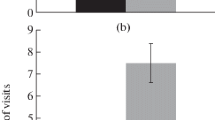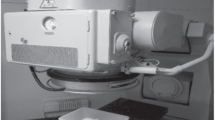Abstract
Irradiation of animals with ultrashort impulses of ultra-broadband magnetic irradiation with an impulse repetition frequency of 6 Hz for 1 h induced changes in the spectral composition of cerebral cortex electrical activity in rats, measured over the 5 min immediately after irradiation, as compared with controls. In particular, there was suppression of frequencies close to the impulse sequence frequency, along with a decrease in interhemisphere coherence. Continuous recording of polygrams for 22 h from rabbits after irradiation revealed a “delayed” effect — a significant increase in paradoxical sleep, starting 16 h after the end of irradiation and persisting to the end of the recording period. It is suggested that irradiation has a direct action both on the mechanisms of generation of the θ rhythm (septohippocampal) and on the system controlling circadian rhythms (the suprachiasmatic nucleus-epiphysis system).
Similar content being viewed by others
REFERENCES
I. M. Akimova T. A. Novikova (1988) ArticleTitleSubcellular mechanism of action of ultra low frequency electromagnetic fields on the cerebral cortex Byull. Éksperim. Biol. Med. 105 738–741
V. M. Koval’zon (1971) ArticleTitleSome features of the electrical activity of the cerebral cortex in white rats in conditions of free behavior Byull. Éksperim. Biol. Med. 71 IssueID3 13–18
V. M. Koval’zon Y. V. Rozhnov I. V. Zhdanova (2000) ArticleTitleMelatonin and sleep in rabbits Proceedings of the XXX All-Russia Conference on Studies in Higher Nervous Activity 2 665–666
V. M. Koval’zon V. L. Tsibul’skii (1985) Characteristics of the paradoxical phase of sleep in laboratory rabbits Sleep as a Factor in the Control of the Functional State of the Body Nauka Leningrad 70–74
V. G. Kolpakov, T. A. Alekhina, N. N. Barykina, et al., “Interhemisphere asymmetry and some features of the behavior of rats with a genetic predisposition to catalepsy,” in: Transmitters in the Genetic Control of Behavior (Proceedings of an All-Union Symposium) [in Russian], Novosibirsk (1986), p. 33.
G. D. Kuznetsova N. I. Nezlina E. V. Petrova (1988) ArticleTitleThermal visualization of interhemisphere asymmetry in the brains of animals Dokl. Akad. Nauk SSSR 302 IssueID2 484–487
L. M. Merkulova Y. A. Kholodov (1996) Responses of Excitable Body Tissues to Pulsed Magnetic Fields Chuvash University Press Cheboksary
E. V. Petrova A. G. Markov (1989) ArticleTitleThermal asymmetry of the rat brain in catalepsy Zh. Vyssh. Nerv. Deyat. 39 IssueID6 1160–1162
E. V. Petrova T. I. Luchkova G. D. Kuznetsova (1992) ArticleTitleInterhemisphere asymmetry of the cerebral cortex of the rabbit in the state of ‘animal hypnosis’ Zh. Vyssh. Nerv. Deyat. 42 IssueID1 129–136
E. V. Petrova T. I. Luchkova A. V. Pirozhenko (1992) ArticleTitleECoG recordings in rats with genetic catalepsy Zh. Vyssh. Nerv. Deyat. 42 IssueID5 1009–1017
A. F. Semiokhina P. Tsurita (1974) ArticleTitleElectrophysiological studies of limited inhibition in an audiogenic seizure model Fiziol. Zh. SSSR 60 IssueID5 695–701
K. B. Sudakov G. D. Antimonii (1977) ArticleTitleThe hypnogenic action of modulated electromagnetic fields Byull. Éksperim. Biol. Med. 84 IssueID8 146–149
Y. A. Kholodov (1975) Responses of the Nervous System to Electromagnetic Fields Nauka Moscow
Y. A. Kholodov N. N. Lebedeva (1992) Responses of the Nervous System to Electromagnetic Fields Nauka Moscow
S. M. Bawin A. R. Sheppard M. D. Mahoney W. R. Adey (1984) ArticleTitleInfluences of sinusoidal electric fields on excitability in the rat hippocampal slice Brain Res. 323 IssueID2 227–237
S. M. Bawin W. N. Satmary R. A. Jones et al. (1996) ArticleTitleExtremely low-frequency magnetic fields disrupt rhythmic slow activity in rat hippocampal slices Bioelectromagnetics 17 IssueID5 388–395
M. F. Dutra Morales O. Y. Galvis-Alonso N. Garcia-Cairasco (2000) ArticleTitleAudiogenic kindling in the Wistar rat: a potential model for recruitment of limbic structures Epilepsy Res. 39 IssueID3 251–259
F. Gamberale B. A. Olson P. Eneroth et al. (1989) ArticleTitleAcute effects of ELF electromagnetic fields: a field study of linesmen working with 400 kV power lines Brit. J. Ind. Med. 46 IssueID10 729–737
J. H. Gogerty, “Preclinical methodologies related to the development of hypnotic substances,” in: Pharmacology of Sleep, R. L. Williams and I. Karacan (eds.), Wiley Med. Publ. (1976), pp. 33–52.
C. Gordon and M. Berk, “Suicide and geomagnetic storms,” in: Abstracts of the 21st CINP Congress, Glasgow (1998).
J. L. Kirschvink and A. K. Kirschvink, “Magnetite biomineralisation in human tissue: a solution to the thermal noise problem of ELF bioeffects,” in: Electricity and Magnetism in Biology and Medicine, M. Blank (ed.), San Francisco Press (1992).
A. R. Liboff (1985) ArticleTitleGeomagnetic cyclotron resonance in living cells J. Biol. Phys. 13 99–102
E. Lyskov J. Juutilainen V. Jousmaki et al. (1993) ArticleTitleInfluence of short-term exposure of magnetic field on the bioelectrical processes of the brain and performance Int. J. Psychophysiol. 14 IssueID3 227–231
E. B. Lyskov J. Juutilainen V. Jousmaki et al. (1993) ArticleTitleEffects of 45 Hz magnetic fields on the functional state of the human brain Bioelectromagnetics 14 IssueID2 87–95
K. Mann J. Roschke (1996) ArticleTitleREM suppression induced by digital mobile radio telephones Wien. Med. Wochenschr. 146 IssueID13-14 285–286
A. W. Preece G. Iwi A. Davies-Smith et al. (1999) ArticleTitleEffect of a 915-MHz simulated mobile phone signal on cognitive function in man Int. J. Radiat. Biol. 75 IssueID4 447–456
A. Schienle R. Stark B. Walter et al. (1997) ArticleTitleEffects of low-frequency magnetic fields on electrocortical activity in humans: a sferics simulation study Int. J. Neurosci. 90 IssueID1-2 21–36
A. R. Sheppard, “Effects of 60-Hz magnetic field on a spontaneously active neuronal system,” in: Proceedings of the 9th Annual Conference of the IEEE Engineering in Medicine and Biology Society, Boston (1987), pp. 79–82.
M. S. Stuckley (1979) ArticleTitleInteraction of radiofrequency and microwave radiation with living systems: review of the mechanisms Rad. Envl. Phys. 16 IssueID1 1–14
Author information
Authors and Affiliations
Additional information
Translated from Rossiiskii Fiziologicheskii Zhurnal imeni I. M. Sechenova, Vol. 89, No. 7, pp. 786–794, July, 2003.
Rights and permissions
About this article
Cite this article
Petrova, E.V., Gulyaeva, N.V., Titarov, S.I. et al. Actions of pulsed ultra-broadband electromagnetic irradiation on the EEG and sleep in laboratory animals. Neurosci Behav Physiol 35, 165–170 (2005). https://doi.org/10.1007/s11055-005-0009-1
Received:
Revised:
Issue Date:
DOI: https://doi.org/10.1007/s11055-005-0009-1




